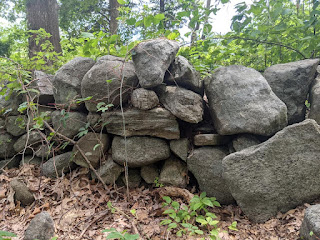or Sebaquanash, "the man who weeps"
Feeling well enough
to do it for the first time in three years, I recently went back to a spot
where a certain stone effigy resides on a “stone wall” on a little hill above a
salt marsh on the CT shoreline. I dropped my bicycle on the ground off the
pathway when I reached the first of the stones near “the site,” not only because
I still haven’t fixed my kickstand yet but also so I can just step over the
bike and then lift it to get back on instead of painfully throwing my leg over
it, a simple little old man’s dance step to avoid the pain in his hip.
I remember thinking
that I may not of been here at just this time of day or I would have noticed
how a perhaps snake head-like stone by the trailside seems to have two possible eyes, one closed and one open, a "thing" that happens to occur on some possibly modified stones "sometimes," in some vague unscientific sounding terms:
And qusuqaniyutôkanuk, on the stone wall, is a Turtle Tobacco Offering Stone:
105. Terrapin. "The name of various sea-tortoises or turtles
of the waters of the South Atlantic
coast of the United States. The word is
derived from one of the southeastern Algonkian dialects, as indicated by the
Virginian torope, " little turtle," Lenape tulpa, turpa, "tortoise," Abnaki toarebe, " tortoise," - the
toonuppasog of the Eliot Bible (Lev. xi.
29) is cognate. In the early writers the forms tarapin, terrapene, terebin, etc., occur,
while the negroes of the South have
adopted the word as tarrypin. Our word terrapin is from a diminutive, as Whitaker, who wrote in I623,
unconsciously recorded, when he spoke of
"the torope, or little turtle.”

























No comments:
Post a Comment